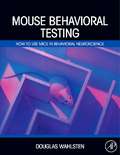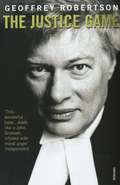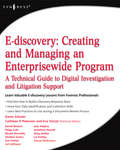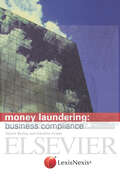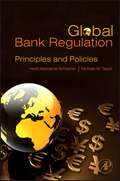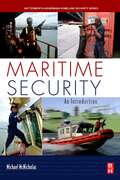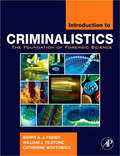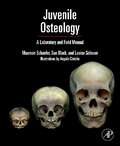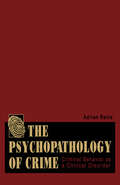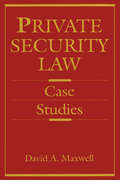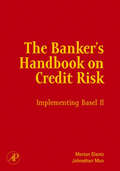- Table View
- List View
Effective Interviewing and Interrogation Techniques
by Nathan J. Gordon William L. FleisherEffective Interviewing and Interrogation Techniques believably answers the question, How do you know when someone is lying? It also provides a guide for interviewing probable suspects and interrogating likely perpetrators on techniques and tradecraft. This book covers topics about searching for truth and revealing lies. It presents forensic assessments based on psychophysiology, and assessments on the basis of non-verbal behavior. The book also covers interview and interrogation preparation, as well as question formulation. It discusses the Morgan Interview Theme Technique or MITT, and the Forensic Assessment Interview or FAINT. The book addresses techniques for interviewing children and the mentally challenged, and offers information about pre-employment interviews. It also explains how to understand aggressive behavior and how to deal with angry people. The book concludes by presenting future methods for searching for the truth. Law enforcement and security professionals, as well as prosecutors, criminal defense lawyers, and civil litigators will find this book invaluable.The only book to address FAINT, IIT, and MITT in one sourceEnables the interviewer to obtain a confession that can stand up in courtIncludes an online workbook with practical exercises to assist the reader
Forensic Criminology
by Brent E. Turvey Wayne Petherick Claire E. FergusonForensic Criminology gives students of criminology and criminal justice an introduction to the forensic realm and the applied forensic issues they will face when working cases within the justice system. It effectively bridges the theoretical world of social criminology with the applied world of the criminal justice system. While most of the competing textbooks on criminology adequately address the application and the social theory to the criminal justice system, the vast majority do not include casework or real-world issues that criminologists face. This book focuses on navigating casework in forensic contexts by case-working criminologists, rather than broad social theory. It also allows criminology/criminal justice instructors outside of the forensic sciences the ability to develop and instruct a core course that might otherwise be considered beyond their expertise, or in conflict with forensic courses taught in chemistry, biology, or medical programs at their institutions because of its focus on criminology and criminal justice careers. With its practical approach, this textbook is well-suited for forensic criminology subjects being taught and developed in law, criminology, and criminal justice programs around the world. Approaches the study of criminology from an applied standpoint, moving away from the purely theoretical Contains relevant and contemporary case examples to demonstrate the application of forensic criminology Provides an integrated philosophy with respect to criminology, forensic casework, criminal investigations, and the law Useful for students and professionals in the area of criminology, criminal justice, criminal investigation, forensic science, and the law
Crime Scene Photography
by Edward M. RobinsonCrime Scene Photography, Second Edition, offers an introduction to the basic concepts of forensic picture-taking. The forensic photographer, or more specifically the crime scene photographer, must know how to create an acceptable image that is capable of withstanding challenges in court. The photographic theory and principles have to be well grounded in the physics of optics, the how-to recommendations have to work, and the end result must be admissible in court. Based on the author's years of experience in the field at both the Arlington County and Baltimore County Police Departments, this book blends the practical functions of crime scene processing with theories of photography to guide the student in acquiring the skills, knowledge, and ability to render reliable evidence. This text has been carefully constructed for ease of use and effectiveness in training and was class-tested by the author at George Washington University. Beginning August 2008, this book will be required reading by the IAI Crime Scene Certification Board for all levels of certification (through August 2011).Over 600 full color photographsTwo new chapters on 'The History of Forensic Photography,' and 'Digital Image Processing of Evidentiary Photography'An essential reference for crime scene photography, including topics such as Composition, the Inverse Square Law, Court Cases affecting photography, Digital Image Processing, and PhotogrammetryRequired reading by the Crime Scene Certification Board of the International Association for Identification (IAI) for all levels of certification
Mouse Behavioral Testing: How to Use Mice in Behavioral Neuroscience
by Douglas WahlstenMouse Behavioral Testing: How to Use Mice in Behavioral Neuroscience provides detailed explanations of how to conduct an experiment on mouse behavior from the initial planning of the research design through every step of the process until the data analysis phase. The book discusses the practical matters that need to be considered carefully when working with any species of animal, such as how many animals need to be tested. It describes the tests and techniques devised specifically for work with mice. Every step of the research process is illustrated with real situations encountered in previous studies. All examples are based on real experiments, and extensive details of several published experiments are provided. The essential features of a behavioral test protocol are outlined, and several complete protocols are provided. Methods to balance the order of tests and determine throughput are described, then a completely balanced order of tests in a complex experiment is presented. The book will be useful for those already familiar with the general principles of research but are new to the realm of behavioral testing of live mice. It will also serve as a text for a formal course, most likely at the graduate level. A guide to running a behavioral testing lab, including the many aspects of mouse research beyond the confines of the specific testDiagrams and photographs are shown for many kinds of apparatus and test situations with sufficient details such as dimensions to enable building of replicasProvides step-by-step instructions on planning and executing behavioral experiments in order to run them successfully
The Justice Game (PDF)
by Geoffrey RobertsonGeoff Robertson was born in Australia, bu came to London in 1970. He made his name as the fearless defender of Oz magazine at the celebrated trial and went on to engage in some of the most newsworthy cases in recent history. He has defended John Stonehouse, Cynthia Payne, Salman Rushdie, Kate Adie, Arthur Scargill, Daniel Sullivan, Gay News, 'The Romans of Britain', 'Niggaz with Attitude', and a pair of foetal earrings. The book includes accounts of recent cases including the defence of a West London gym owner against the Prince of Wales, the Matrix Churchill affair, and the defence of the Guardian in the cash-for-questions affair. Hugely readable, funny, scandalous, revelator, this will become one of the great books about the law.
Effective Interviewing and Interrogation Techniques
by Nathan J. Gordon William L. FleisherEffective Interviewing and Interrogation Techniques believably answers the question, How do you know when someone is lying? It also provides a guide for interviewing probable suspects and interrogating likely perpetrators on techniques and tradecraft. This book covers topics about searching for truth and revealing lies. It presents forensic assessments based on psychophysiology, and assessments on the basis of non-verbal behavior. The book also covers interview and interrogation preparation, as well as question formulation. It discusses the Morgan Interview Theme Technique or MITT, and the Forensic Assessment Interview or FAINT. The book addresses techniques for interviewing children and the mentally challenged, and offers information about pre-employment interviews. It also explains how to understand aggressive behavior and how to deal with angry people. The 4th Edition adds several Chapters on how to ascertain maximum information from victims and witnesses. The book concludes by presenting future methods for searching for the truth. Law enforcement and security professionals, as well as prosecutors, criminal defense lawyers, and civil litigators will find this book invaluable.The only book to address FAINT, Integrated Interrogation Technique, Forensic Statement Analysis and MITT in one sourceSeveral Chapters on ascertaining information from witnesses and victimsEnables the interviewer to obtain a confession that can stand up in court
Effective Interviewing and Interrogation Techniques
by Nathan J. Gordon William L. FleisherEffective Interviewing and Interrogation Techniques believably answers the question, How do you know when someone is lying? It also provides a guide for interviewing probable suspects and interrogating likely perpetrators on techniques and tradecraft. This book covers topics about searching for truth and revealing lies. It presents forensic assessments based on psychophysiology, and assessments on the basis of non-verbal behavior. The book also covers interview and interrogation preparation, as well as question formulation. It discusses the Morgan Interview Theme Technique or MITT, and the Forensic Assessment Interview or FAINT. The book addresses techniques for interviewing children and the mentally challenged, and offers information about pre-employment interviews. It also explains how to understand aggressive behavior and how to deal with angry people. The 4th Edition adds several Chapters on how to ascertain maximum information from victims and witnesses. The book concludes by presenting future methods for searching for the truth. Law enforcement and security professionals, as well as prosecutors, criminal defense lawyers, and civil litigators will find this book invaluable.The only book to address FAINT, Integrated Interrogation Technique, Forensic Statement Analysis and MITT in one sourceSeveral Chapters on ascertaining information from witnesses and victimsEnables the interviewer to obtain a confession that can stand up in court
The Bioarchaeology of Metabolic Bone Disease
by Simon Mays Megan B. Brickley Rachel IvesThe Bioarchaeology of Metabolic Bone Disease, Second Edition is a comprehensive source dedicated to better understanding this group of conditions that have significant consequences for health in both past and present communities on a global scale. This edition presents an updated introduction to the biology and metabolism of mineralised tissues that are fundamental to understanding the expression of the metabolic bone diseases in skeletal remains. The extensive advances in understanding of these conditions in both bioarchaeological and biomedical work are brought together for the reader. Dedicated chapters focussing on each disease emphasise the integration of up-to-date clinical background with the biological basis of disease progression to give guidance on identification. New chapters covering anaemia and approaches to recognising the co-occurrence of pathological conditions have been included, reflecting recent advances in research. Boxes highlighting significant issues, use of information from sources such as texts and nonhuman primates, and theoretical approaches are included in the text. Each chapter closes with ‘Core Concepts’ that summarise key information. The final chapter reviews current challenges in bioarchaeology and provides directions for future research. This is a must-have resource for users at all career stages interested in integrating information on the metabolic bone diseases into bioarchaeological projects.Covers deficiencies of vitamin C and D, osteoporosis (age-related and secondary), Paget’s disease of bone, anaemia and approaches to disease co-occurrenceContains clear and user-friendly guidance for macroscopic, radiological and microscopic diagnosesHighlights current inquiries and debates in biological anthropology, bioarchaeology, palaeopathology, medical history and clinical/biomedical researchExtensive figures, most new or updated, provide invaluable information on biological processes and lesion expression through diagrams and photographs
Fundamentals of Forensic DNA Typing
by John M. ButlerFundamentals of Forensic DNA Typing is written with a broad viewpoint. It examines the methods of current forensic DNA typing, focusing on short tandem repeats (STRs). It encompasses current forensic DNA analysis methods, as well as biology, technology and genetic interpretation. This book reviews the methods of forensic DNA testing used in the first two decades since early 1980’s, and it offers perspectives on future trends in this field, including new genetic markers and new technologies. Furthermore, it explains the process of DNA testing from collection of samples through DNA extraction, DNA quantitation, DNA amplification, and statistical interpretation. The book also discusses DNA databases, which play an important role in law enforcement investigations. In addition, there is a discussion about ethical concerns in retaining DNA profiles and the issues involved when people use a database to search for close relatives. Students of forensic DNA analysis, forensic scientists, and members of the law enforcement and legal professions who want to know more about STR typing will find this book invaluable.Includes a glossary with over 400 terms for quick reference of unfamiliar terms as well as an acronym guide to decipher the DNA dialectContinues in the style of Forensic DNA Typing, 2e, with high-profile cases addressed in D.N.A.Boxes-- "Data, Notes & Applications" sections throughoutAncillaries include: instructor manual Web site, with tailored set of 1000+ PowerPoint slides (including figures), links to online training websites and a test bank with key
Serial Crime: Theoretical and Practical Issues in Behavioral Profiling
by Wayne PetherickSerial Crime, Second Edition, examines serial predatory behavior and is divided into two main parts. Part one deals with behavioral profiling, and covers a variety of critical issues from the history of profiling and the theoretical schools of thought to its treatment in the mainstream media. This updated edition includes new sections on the problems of induction, metacognition in criminal profiling, and investigative relevance. Part two deals more specifically with a number of types of serial crime including stalking, rape, murder, and arson. Chapters on each of these crimes provide definitions and thresholds, and discussions of the offenders, the crime, and its dynamics. Considerations for behavioral profiling and investigations and the development of new paradigms in each area are interwoven throughout. Topics are conceptually and practically related since profiling has typically seen most application in serial crimes and similar investigations. The unique presentation of the book successfully connects the concepts and creates links to criminal behavior across crimes—murder, sexual assault, and arson—something no other title does. The connection of serial behavior to profiling, the most useful tool in discovering behavior patterns, is also new to the body of literature available and serves to examine the ideal manner in which profiling can be used in conjunction with behavioral science to positively affect criminal investigations.Provides a theoretical and practical foundation for understanding the motivation and dynamics in a range of serial offensesIllustrates the promise, purposes and pitfalls of behavioral profiling in the investigation of various serial crimesNumerous case examples show the real world uses of behavioral profiling in investigations, as well as highlighting a variety of issues in understanding and investigating serial crime
Fundamentals of Forensic Science
by Max M. Houck Jay A. SiegelFundamentals of Forensic Science, Second Edition, provides an introduction to the basic principles of forensic science. The book begins at a crime scene and ends in the courtroom. The book is divided into six parts. Part 1 provides an overview of criminal justice and forensic science, covering the basics of crime scene investigation and the nature of evidence. Part 2 discusses analytical tools, including microscopy, Raman spectroscopy, mass spectrometry, atomic spectroscopy, and separation methods. Parts 3 to 5 discuss the various types of forensic evidence collected, categorized by the types of science employed in their analysis: physical science, chemical science, and biological science. These include pathology; anthropology and odontology; entomology; serology and bloodstain pattern analysis; DNA analysis; forensic hair examinations; forensic toxicology; fiber and paint analysis; friction ridge examination; and firearms and tool marks. Part 6 discusses the legal aspects of forensic science. The book is written for students with a background in basic science, and it is can be used in a one-semester or two-semester format. Vivid, full-color illustrations that diagram key concepts and depict evidence encountered in the fieldStraightforward unit organization that includes key terms, numerous feature boxes emphasizing Internet resources, historical events in forensic science, practical issues in laboratory analysis, and topics for further reading Effective pedagogy, including end-of-chapter questions, paired with a clear writing style makes this an invaluable resource for professors and students of forensic science
The Law of Emergencies: Public Health and Disaster Management
by Nan D. HunterThe Law of Emergencies discusses the legal framework for disaster response and emergency management. The book engages with and debates some of the most important Constitutional issues of our time, such as the tension between civil liberties and national security. It also examines how the law of emergencies plays out in the context of real life emergencies where individuals often have to make split-second decisions. It analyzes legal authority at the federal, state and local levels, placing the issues in historical context but concentrating on contemporary questions. This book includes primary texts, reader-friendly expository explanations, and sample discussion questions. Prior knowledge of the law is not necessary in order to use and understand this book. The contents are organized into 13 substantive chapters plus two additional chapters with problem sets, making the book especially easy to use for a separate course focused on law. The book leads students through the process of understanding both what the law requires and how to analyze issues for which there is no clear legal answer. It features materials on such critical issues as how to judge the extent of Constitutional authority for government to intervene in the lives and property of American citizens. At the same time, it also captures bread-and-butter issues such as responder liability and disaster relief methods. No other book brings these components together in a logically organized, step by step fashion. The book also features case studies of high-risk scenarios including pandemic flu, together with charts and text boxes for clarification. This book will be of interest to graduate and undergraduate students studying the major legal principles underlying emergency management and homeland security policy and operations; professionals in EM and HS; and private-sector risk managers.* Features case studies of high-risk scenarios including pandemic flu* Offers extensive analysis of legal issues from a distinguished scholar, together with charts and text boxes for clarification* Teaches readers how to think about issues crucial to the life and liberty of US citizens, including the limits of constitutional authority
E-discovery: A Technical Guide to Digital Investigation and Litigation Support
by Karen A. SchulerOne of the hottest topics in computer forensics today, electronic discovery (e-discovery) is the process by which parties involved in litigation respond to requests to produce electronically stored information (ESI). According to the 2007 Socha-Gelbmann Electronic Discovery Survey, it is now a $2 billion industry, a 60% increase from 2004, projected to double by 2009. The core reason for the explosion of e-discovery is sheer volume; evidence is digital and 75% of modern day lawsuits entail e-discovery.A recent survey reports that U.S. companies face an average of 305 pending lawsuits internationally. For large U.S. companies ($1 billion or more in revenue)that number has soared to 556 on average, with an average of 50 new disputes emerging each year for nearly half of them. To properly manage the role of digital information in an investigative or legal setting, an enterprise--whether it is a Fortune 500 company, a small accounting firm or a vast government agency--must develop an effective electronic discovery program. Since the amendments to the Federal Rules of Civil Procedure, which took effect in December 2006, it is even more vital that the lifecycle of electronically stored information be understood and properly managed to avoid risks and costly mistakes. This books holds the keys to success for systems administrators, information security and other IT department personnel who are charged with aiding the e-discovery process.*Comprehensive resource for corporate technologists, records managers, consultants, and legal team members to the e-discovery process, with information unavailable anywhere else*Offers a detailed understanding of key industry trends, especially the Federal Rules of Civil Procedure, that are driving the adoption of e-discovery programs*Includes vital project management metrics to help monitor workflow, gauge costs and speed the process
Money Laundering: business compliance
by Stuart Bazley Caroline FosterMoney Laundering: Business Compliance is a timely and user-friendly manual that shows you how to comply fully and effectively with the Money Laundering Regulations 2003. In the drive to halt funding terrorist activity, control of money laundering activity has risen high on the government’s agenda. The Money Laundering Regulations 2003 expand the regulator’s already wide powers. Failure to comply with anti-money laundering provisions prevents businesses functioning properly, carries severe financial penalties and can result in serious criminal sanctions. Using flowcharts, diagrams, checklists and bullet points, this book explains how you can spot activities that must be reported. It alerts you to when and how you must report and to do so within minimum business interruption; demonstrates how to ensure compliance with the regulatory framework; gives details on correct training procedures; tells you how to avoid falling foul of the stringent rules against tipping off; and arms you with the knowledge to avoid the pitfalls. With its uniquely practical approach and hands-on guidance, the book should be the first port of call for all those wanting to understand the regulations and the guidance notes. This book is essential reading for MLROs, directors, compliance officers, risk officers, finance directors and accountants, company secretaries and all those within the regulated sector.
Securing Intellectual Property: Protecting Trade Secrets and Other Information Assets
by Information SecurityMost employeers are astounded at how easily and quickly their proprietary information can get out of their control. In a large number of cases, theft of trade secrets often involves employees leaving a company to start their own business or work for a direct competitor.Nearly all books that address the topic of trade secrets have the “spy vs. spy" perspective. The author approaches the topic from a practical business perspective and not simply creating “paranoia" for paranoia’s sake. The material for this book comes from the author’s extensive work experience as a computer forensics consultant and manager on numerous theft of trade secrets cases.No-nonsense solutions to the most common intellectual property problems facing security managers, computer security professionals, corporate legal counsel, and human resource managersSample agreements and forms that address specific business needsCoverage of threats ranging from physical security lapses to hackers to social engineering
Global Bank Regulation: Principles and Policies
by Michael W. Taylor Heidi Mandanis SchoonerGlobal Bank Regulation: Principles and Policies covers the global regulation of financial institutions. It integrates theories, history, and policy debates, thereby providing a strategic approach to understanding global policy principles and banking. The book features definitions of the policy principles of capital regularization, the main justifications for prudent regulation of banks, the characteristics of tools used regulate firms that operate across all time zones, and a discussion regarding the 2007-2009 financial crises and the generation of international standards of financial institution regulation. The first four chapters of the book offer justification for the strict regulation of banks and discuss the importance of financial safety. The next chapters describe in greater detail the main policy networks and standard setting bodies responsible for policy development. They also provide information about bank licensing requirements, leading jurisdictions, and bank ownership and affiliations. The last three chapters of the book present a thorough examination of bank capital regulation, which is one of the most important areas in international banking. The text aims to provide information to all economics students, as well as non-experts and experts interested in the history, policy development, and theory of international banking regulation.Defines the over-arching policy principles of capital regulationExplores main justifications for the prudent regulation of banksDiscusses the 2007-2009 financial crisis and the next generation of international standards of financial institution regulation Examines tools for ensuring the adequate supervision of a firm that operates across all time zones
Principles of Addictions and the Law: Applications in Forensic, Mental Health, and Medical Practice
by Norman S. MillerThe book includes an examination of sources of law important to addiction and its treatment. The foundations for forensic work in professional legal testimony is explored (e.g., legal system, case law precedent, statutes governing addictions, civil and criminal procedures). The science of addiction is featured including the biology of addiction, addiction as a brain disease, responsibility vs. loss of control, development of addictions, and the role of genetics and environment. Drug testing, its uses with forensic populations, what the tests show and do not show, controversies in using tests in the general population also receives extensive treatment. Addiction and mental illness in forensic populations is highlighted for addiction treatment and continuing care. Case studies and landmark cases illustrate the role of alcohol, drug use, and addictions in legal decisions.Focused primarily on alcohol and drug addictionsCase studies and landmark cases are included to illustrate the role of alcohol/drugs in legal decisions (e.g., the Exxon Valdez case)Brief overview of legal system and drug courts will be useful to clinicans, lawyers, administrators, and other professionals
Digital Evidence and Computer Crime: Forensic Science, Computers, and the Internet
by Eoghan CaseyDigital Evidence and Computer Crime, Third Edition, provides the knowledge necessary to uncover and use digital evidence effectively in any kind of investigation. It offers a thorough explanation of how computer networks function, how they can be involved in crimes, and how they can be used as a source of evidence. In particular, it addresses the abuse of computer networks as well as privacy and security issues on computer networks. This updated edition is organized into five parts. Part 1 is about digital forensics and covers topics ranging from the use of digital evidence in the courtroom to cybercrime law. Part 2 explores topics such as how digital investigations are conducted, handling a digital crime scene, and investigative reconstruction with digital evidence. Part 3 deals with apprehending offenders, whereas Part 4 focuses on the use of computers in digital investigation. The book concludes with Part 5, which includes the application of forensic science to networks. New to this edition are updated information on dedicated to networked Windows, Unix, and Macintosh computers, as well as Personal Digital Assistants; coverage of developments in related technology and tools; updated language for search warrant and coverage of legal developments in the US impacting computer forensics; and discussion of legislation from other countries to provide international scope. There are detailed case examples that demonstrate key concepts and give students a practical/applied understanding of the topics, along with ancillary materials that include an Instructor's Manual and PowerPoint slides. This book will prove valuable to computer forensic students and professionals, lawyers, law enforcement, and government agencies (IRS, FBI, CIA, CCIPS, etc.). Named The 2011 Best Digital Forensics Book by InfoSec ReviewsProvides a thorough explanation of how computers & networks function, how they can be involved in crimes, and how they can be used as evidence Features coverage of the abuse of computer networks and privacy and security issues on computer networks
Forensic Comparative Science: Qualitative Quantitative Source Determination of Unique Impressions, Images, and Objects
by John R. VanderkolkWhile there is no such thing as a perfect match in the field of forensic comparative science, Forensic Comparative Science: Qualitative Quantitative Source Determination of Unique Impressions, Images, and Objects provides the experience, understanding, and judgment, necessary for concluding whether two unique images share common origin from a unique and persistent source. Knowing there will be ranges of different levels of details throughout images, the expert must be able to comprehend when a sufficient quality and quantity of details is reached to render a judgment. By utilizing a process of analyzing the first image, analyzing the second image, comparing them to each other, and evaluating the significance of the analyses and comparisons based on expertise, the comparative scientist will be able to recognize the belief and believe the recognition that occurs during comparative examinations. Forensic Comparative Science presents a philosophical and theoretical approach to explaining the cognitive process of comparative measurements and source determination. Science is about understanding and generalizing nature. This book is about generalizing comparative science.Brings the comparative sciences under one philosophy of understanding in regards to terminology, examination method and standards for conclusions Provides standards for conclusions including sufficiency vs. insufficiency for comparisons, individualization, agreement vs. disagreement, and levels of detail required Not only helps gaining scientific and technical knowledge but also helps to understand and appreciate the importance of the comparative sciences to the criminal justice system A ‘must read’ for any forensic science student with an interest in comparative sciences, all trainees in forensic laboratories, and active examiners throughout the world wanting a compilation of many disciplines under one generalized philosophy of examination
Maritime Security: An Introduction
by Michael McNicholasThe commercial maritime sector is highly vulnerable to theft and piracy, and presents a probable target for a major terrorist attack. The best way to prevent losses is to apply lessons learned in another arena-–the struggle to curb drug smuggling. This effort has shown that successes can be achieved when effective and comprehensive security measures and procedures are implemented at key initial links in the cargo supply chain. The integrity and security of whole system are improved when efforts are focused at the primary "choke point" – the load seaports and their ships. This book provides practical, experience-based, and proven knowledge - and a "how-to-guide" - on maritime security. McNicholas explains in clear language how commercial seaports and vessels function; what threats currently exist; what security policies, procedures, systems, and measures must be implemented to mitigate these threats; and how to conduct ship and port security assessments and plans. Whether the problem is weapons of mass destruction or cargo theft, Maritime Security provides invaluable guidance for the professionals who protect our shipping and ports.Holds the keys to successfully designing, implementing, and managing effective port and vessel security programs in a high-risk environmentProvides real-world experience in Maritime Security from the Managing Director of Phoenix Management Services Group in the USA and Panama.Offers specifics of a model port security program and case studies of effective tactics in a high-threat environment
Introduction to Criminalistics: The Foundation of Forensic Science
by William J. Tilstone Barry A.J. Fisher Catherine WoytowiczIntroduction to Criminalistics covers the basics of Criminalistics in a textbook for a one or two semester course, with the intention of preparing the student for a future in forensic science. The role of the Criminalist is to analyze, compare, identify, and interpret physical evidence in the crime lab. These crime labs, or forensic labs, have two primary functions: identifying evidence and linking the suspect, victim, and crime scene through physical evidence. This new primer introduces the learner to the structure and organization of the crime lab and to the role of the Criminalist. It features real cases – recent and historic – to illustrate concepts. Colorful pedagogy clearly defines chapter elements and sets this text apart from next best. Topics covered include how to process a crime scene and preserve evidence, the basic principles of firearm examination, latent fingerprints, and rudimentary toxicology, or how to determine the presence or absence of drugs and poisons. Well organized and methodical, this textbook has the potential to become the standard text for applying techniques of the physical and natural sciences to examining physical evidence. Uses real cases – recent and historic – to illustrate conceptsColorful pedagogy clearly defines chapter elements and sets this text apart from next bestPresents the basics of forensic sciences in a one-semester or one-year courseOffers excellent preparation for professional examinationsDelivers the latest in laboratory technique while acknowledging the limits of technology
Juvenile Osteology: A Laboratory and Field Manual
by Sue Black Louise Scheuer Maureen C. SchaeferThe need for a laboratory and field manual to assist with the evaluation of juvenile skeletal material is long overdue. This resource is essential for the practising osteoarchaeologist and forensic anthropologist who requires a quick, reliable and easy-to-use reference to aid in the identification, siding and aging of juvenile osseous material. While excellent reference books on juvenile osteology are currently available, no pre-existing source adequately fills this particular niche in the market. This field manual is designed with practicality as its primary directive. Descriptions of each bone contain 1) morphological characteristics useful for identification, 2) other elements with which the bone may be confused, 2) tips for siding, 3) illustrations of varying developmental phases, 4) data useful for ageing, and 5) a summary of developmental timings. Concise, bullet-style descriptions assist with quick retrieval of information.Unique to this manual is the presentation of data collected from a variety of populations, utilizing a range of observational methods, as an alternative to providing one overall aging summary that is derived from a compilation of many individual sources. This manual provides a host of data on a variety of populations to enable the user to select the reference most applicable to their needs. The final chapter combines information from each bone to provide a summary of developmental changes occurring at different life stages to act as an immediate 'ready reckoner' for the knowledgeable practitioner. It also provides forms useful for documenting juvenile material and diagrams to help with the recognition of commingled juvenile remains. The manual is a must for anyone responsible for the evaluation of juvenile osseous material through dry bone assessment, radiographs, sonograms, and or CT scans.*Identifies every component of the developing skeleton *Provides detailed analysis of juvenile skeletal remains and the development of bone as a tissue *Summarizes key morphological stages in the development of every bone*Provides data on a variety of populations to enable the user to select the reference most applicable to their needs*Focuses on practicality, with direct, bullet style descriptions*Provides forms for documenting juvenile material*Provides diagrams to help with the recognition of commingled juvenile remains*Final chapter provides summary of developmental changes occurring at different life stages to act as an immediate 'ready reckoner' for the practitioner
The Psychopathology of Crime: Criminal Behavior as a Clinical Disorder
by Adrian RaineThis book takes an uncompromising look at how we define psychopathology and makes the argument that criminal behavior can and perhaps should be considered a disorder. Presenting sociological, genetic, neurochemical, brain-imaging, and psychophysiological evidence, it discusses the basis for criminal behavior and suggests, contrary to popular belief, that such behavior may be more biologically determined than previously thought.Presents a new conceptual approach to understanding crime as a disorderIs the most extensive review of biological predispositions to criminal behavior to dateAnalyzes the familial and extra-familial causes of crimeReviews the predispositions to crime including evolution and genetics, and the neuropsychological, psychophysiological, brain-imaging, neurochemical, and cognitive factorsPresents the practical implications of viewing crime as a psychopathology in the contexts of free will, punishment, treatment, and future biosocial research
Private Security Law: Case Studies
by David MaxwellPrivate Security Law: Case Studies is uniquely designed for the special needs of private security practitioners, students, and instructors. Part One of the book encompasses negligence, intentional torts, agency contracts, alarms, and damages. Part Two covers authority of the private citizen, deprivation of rights, and entrapment.The factual cases presented in this book touch on the everyday duties of persons associated with the private security industry. Private Security Law: Case Studies provides a basic orientation to problems capable of inciting litigation. The information presented through case laws comes from cases chosen for their factual, realistic, and practical connection to the private security industry. This focused approach addresses specific problem areas of the industry and provides information necessary to a security manager to avert future loss.Specially designed for private security practitioners, instructors, and students.Examines cases that are practical, realistic and relevant to specific areas of private security.Provides the information security managers need to avoid future problems.
The Banker's Handbook on Credit Risk: Implementing Basel II
by Morton Glantz Johnathan MunThe Banker's Handbook on Credit Risk shows you how to comply with Basel II regulations on credit risk step by step, building on the basics in credit risk up to advanced credit risk methodologies. This advanced credit/risk management book takes a "new tools" approach to Basel II implementation. The hands-on applications covered in this book are vast, including areas of Basel II banking risk requirements (credit risk, credit spreads, default risk, value at risk, market risk, and so forth) and financial analysis (exotic options and valuation), to risk analysis (stochastic forecasting, risk-based Monte Carlo simulation, portfolio optimization) and real options analysis (strategic options and decision analysis). This book is targeted at banking practitioners and financial analysts who require the algorithms, examples, models, and insights in solving more advanced and even esoteric problems. The book comes complete with a DVD filled with sample modeling videos, case studies, and software applications to help the reader get started immediately. The various trial software applications included allows the reader to quickly access the approximately 670 modeling functions, 250 analytical model templates, and powerful risk-based simulation software to help in the understanding and learning of the concepts covered in the book, and also to use the embedded functions and algorithms in their own models. In addition, the reader can get started quickly in running risk-based Monte Carlo simulations, run advanced forecasting methods, and perform optimization on a myriad of situations, as well as structure and solve customized real options and financial options problems.* Only book to show bankers step by step how to comply with Basel II regulations on credit risk* Over 150 hands-on software applications included on the DVD accompanying the book, including sample modeling videos * Provides all the latest quantitative tools



